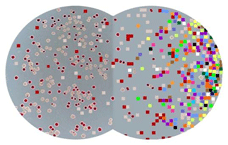TA agar plates
We use TA (short for tetrazolium and arabinose) agar for distinguishing Ara- and Ara+ strains in most competition assays. Colonies of Ara- strains typically appear red on TA agar, while those of Ara+ strains appear white. TA plates are generally incubated at 37°C for 24 h.
(It can take a bit of skill in scoring smaller colonies; the "halo" of all colonies is white, and small red colonies--such as on crowded plates or for certain derived lines that produce smaller colonies--consist mostly of a halo and thus appear white. A practiced eye, however, learns to distinguish these effects.)
The following recipe is for 1 liter, which should make about 45 plates.
| Tryptone | 10 g | ||
| Yeast extract | 1 g | ||
| Sodium chloride | 5 g | ||
| Agar | 16 g | ||
| Antifoam (5%) | 1 ml | ||
| dH20 | 1000 ml | ||
| L(+)Arabinose | 10 g | ||
| TTC (5%) | 1 ml | [TTC is the tetrazolium indicator dye. We use Sigma T8877.] | |
Split the water, and autoclave the arabinose separately from the rest of the medium. Combine the two parts after autoclaving, and then add the TTC from a sterile stock solution and mix.
One can employ other sugars instead of arabinose and use the same approach to distinguish, for example, Lac- and Lac+ strains. (See Levin, B. R., F. M. Stewart, and L. Chao. 1977. Resource-limited growth, competition, and predation: a model and experimental studies with bacteria and bacteriophage. Am. Nat. 111:3-24.)
